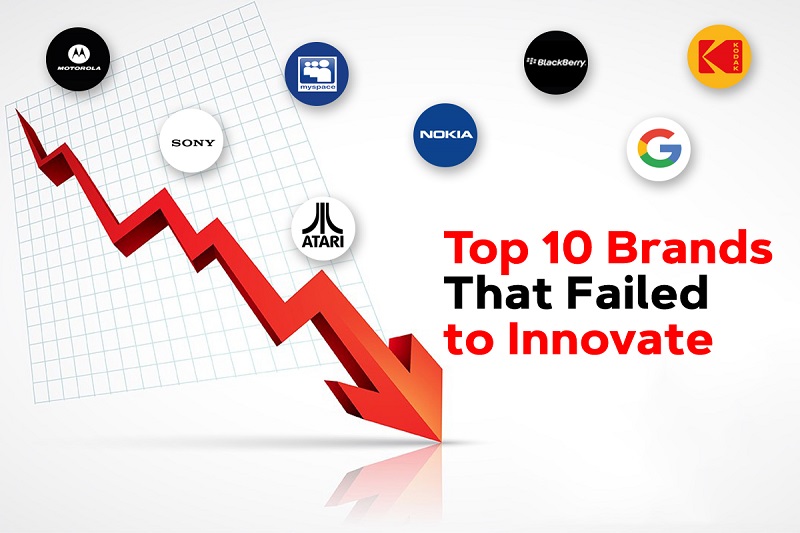Innovation is the lifeblood of business. Companies that fail to adapt to changing market trends and consumer needs often struggle to stay relevant. Here are ten top brands that serve as cautionary tales for failing to innovate in time.

1. Blockbuster
At its peak, Blockbuster was the king of video rentals, with thousands of stores worldwide. However, the company’s inability to transition to digital streaming spelled its doom. Blockbuster famously passed on the opportunity to buy Netflix for $50 million in 2000, underestimating the potential of online streaming. Netflix’s rise and Blockbuster’s refusal to adapt led to the latter’s eventual bankruptcy in 2010.
2. Kodak
Kodak was once synonymous with photography, dominating the global camera and film market. Ironically, Kodak invented the digital camera in 1975 but failed to capitalize on it, fearing it would cannibalize its film business. As competitors like Canon and Nikon embraced digital technology, Kodak lost its market share, eventually filing for bankruptcy in 2012.
3. Nokia
Nokia was a pioneer in the mobile phone industry and at one time held over 40% of the global market share. However, its reluctance to embrace the smartphone revolution, particularly touchscreen technology and app ecosystems, allowed competitors like Apple and Samsung to dominate. By the time Nokia adopted Android, it was too late, and the brand faded into irrelevance in the mobile market.
4. Toys “R” Us
Toys “R” Us was a beloved toy retailer for decades, but its failure to adapt to e-commerce trends led to its downfall. Despite partnering with Amazon in the early 2000s, the company did not develop its own robust online platform. Coupled with mounting debt and stiff competition from online retailers like Amazon and Walmart, Toys “R” Us filed for bankruptcy in 2017.
5. Yahoo
Yahoo was once a leader in internet services, including search, email, and news. However, its lack of focus and a series of poor strategic decisions, such as rejecting a $44 billion acquisition offer from Microsoft in 2008, contributed to its decline. Yahoo failed to compete with Google in search and Facebook in social media, eventually being acquired by Verizon in 2017 for a fraction of its former value.
6. BlackBerry
BlackBerry was a trailblazer in the smartphone market, known for its physical keyboards and secure email services. However, its failure to innovate and adapt to touchscreen technology and app ecosystems allowed Apple and Android devices to dominate. By the time BlackBerry pivoted, its market share had dwindled to insignificance.
7. MySpace
Once a dominant force in social networking, MySpace failed to keep up with the evolving features and user experience offered by competitors like Facebook. Poor management decisions and an inability to adapt to the changing digital landscape led to its rapid decline.
8. Sears
Sears was a retail giant for over a century, pioneering the mail-order catalog. However, its failure to adapt to the rise of e-commerce and modernize its stores led to a steady decline. With mounting debt and stiff competition from Amazon and Walmart, Sears filed for bankruptcy in 2018.
9. Pan Am
Once a symbol of luxury air travel, Pan Am failed to adapt to changing industry dynamics, such as deregulation and rising fuel costs. The company’s inability to manage operational inefficiencies and diversify its revenue streams led to its bankruptcy in 1991.
10. Xerox
Xerox was a pioneer in photocopying and computing technology. Despite inventing key innovations like the graphical user interface and the mouse, Xerox failed to capitalize on these breakthroughs. Other companies, such as Apple, reaped the benefits of Xerox’s innovations, leaving Xerox struggling to maintain relevance.
Lessons Learned
These cautionary tales highlight the importance of:
- Adapting to Technology Trends: Companies must embrace disruptive technologies rather than fear them.
- Understanding Consumer Behavior: Keeping a pulse on what customers want and need is critical to staying relevant.
- Agility in Business Models: Flexibility to pivot or evolve is often the key to long-term survival.
Innovation isn’t just about creating new products—it’s about staying ahead of the curve and being willing to change. These brands serve as reminders of what happens when businesses fail to do so.


Leave a Reply